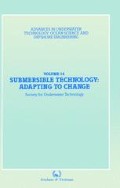Abstract
A review of the symptomatology of decompression sickness must make reference to present understanding of the cause of the condition. Since Boyle1,2 was able to produce decompression sickness (DCS) in animals by changes in ambient pressure, it has been held that at least the initial stimulus to the development of the condition is the formation of bubbles of inert gas within tissues and small blood vessels. The converse of this process, achieving elimination of these bubbles by recompression, was first realized in 1863.3 The mechanical effects of undissolved gas liberated from solution within tissues and the bloodstream are not, however, sufficient to explain the variable symptomatology, and cannot account for variations in individual susceptibility, time of onset, duration, and the nature of the response to treatment. Explanations of the pathophysiology of decompression sickness are not complete, but it has been known since 19374 that activity at the surface of undissolved gas has the potential in plasma for causing alterations in the structure and reactivity of substances within the plasma. It is currently thought5 that these alterations may lead to the denaturing of plasma proteins and the formation of lipid micelles from triglycerides, sterols and fatty acids normally contained within blood lipoproteins. These changes in the macromolecular constitution of blood will lead to changes in the flow characteristics of blood,5 with increased viscosity and decreased local flow.
Access this chapter
Tax calculation will be finalised at checkout
Purchases are for personal use only
Preview
Unable to display preview. Download preview PDF.
References
Boyle, R. New pneumatical observations about respiration, Phil. Trans. R. Soc. London 1670; 5 2011 – 2031.
Boyle, R. Continuation of observations concerning respiration, Phil. Trans. R. Soc. London 1670; 5 2035 – 2056.
Foley, A. E. Du Travail dans l’Air Comprimé. Étude Médicale, Hygiéniue et Biologique Faite au Pont d’Argenteuil, Paris: Bert, 1863.
Bull, H. B. and Neurath. H. The denaturation and hydration of proteins. II. Surface denaturation of egg albumin J. Biol. Chem. 1937; 119 163–175.
Hallenbeck, J. M. and Andersen, J. C. Pathogenesis of the decompression disorders, in P. B. Bennett and D. H. Elliott (Eds),The Physiology and Medicine of Diving, London: Baillière Tindall, 1982. 435–460.
Swindle, P. F. Occlusion of blood vessels by agglutinated red cells, mainly as seen in tadpoles and very Young kangaroos, Am. J. Physiol. 1937; 120 59–74.
Lee, W. H. and Hairston, P. Structural effects on blood proteins at the as-blood interface, Fedn. Proc. 1971; 30, 1615–1622.
Goldin, F. C. Grifths P. Hempleman H. V. Paton W. D. M. and Walder D. N. Decompression sickness during construction of the Dartford Tunnel, Br. J. Ind. Med. 1960; 17, 167–180.
Elliott D. H. and Kindwall E. P. Manifestations of the decompression disorders in P. B. Bennett and D. H. Elliott Eds, The Physiology and Medicine of Diving, London: Bailliere Tindall, 1982. 461–472.
Doll, R. E. Decompression sickness among US Navy operational divers: an estimate of incidence using air-decompression tables Navy Experimental Diving, Unit 1965 Research Report 4–64.
Ciria Underwater Engineering Group. RNPL Metric Air Diving Tables, 1976; Report UR7.
Hanson R. de G. and Sowden R. R. Trials for testing diving tables, Admiralty Marine Technology Establishment 1979 Tech Memo AMTS(E) TM 79, 403.
Hennessy, T. R. Decompression Diving: Which Tables to Use South African Underwater Union 1975.
Shields, T. G. and Lee, W. B. The incidence of decompression sickness arising from commercial offshore air diving operations in the UK sector of the North Sea during 1982–83. Department of Energy, London, 1986.
Department of Energy. Diving Safety Memorandum No. 7/86. Department of Energy, London, 1986.
Slark, A. G. Treatment of 137 cases of decompression sickness, Medical Research Council, RN Personnel Research Committee Report 1962; 63/1030.
Rivera, J. C. Decompression sickness among divers: an analysis of 935 cases, Milit. Med. 1964; 129: 314–334.
Behnke, A. R. Decompression sickness following exposures to high pressures, in J. F. Fulton (Ed.), Decompression Sickness, London, Philadelphia: Saunders, 1951.
Rashbass, C. Aetiology of itching on decompression, Medical Research Council, RN Personnel Research Committee Report 1957; UPS 167.
Miles, S. Underwater Medicine, London: Staples Press, 1966.
Philp, R. B., Inwood, M. J. and Warren, B. A. Interaction between gas bubbles and components of the blood: implications in decompression sickness, Aerospace Med. 1972; 43, 946–956.
Author information
Authors and Affiliations
Rights and permissions
Copyright information
© 1988 Society for Underwater Technology (Graham & Trotman)
About this paper
Cite this paper
Childs, C.M. (1988). Clinical Presentations and Significance of Decompression Sickness: an Analysis of Incidents from Commercial Diving Operations 1977–87. In: Submersible Technology: Adapting to Change. Advances in Underwater Technology, Ocean Science and Offshore Engineering, vol 14. Springer, Dordrecht. https://doi.org/10.1007/978-94-009-1299-1_21
Download citation
DOI: https://doi.org/10.1007/978-94-009-1299-1_21
Publisher Name: Springer, Dordrecht
Print ISBN: 978-94-010-7078-2
Online ISBN: 978-94-009-1299-1
eBook Packages: Springer Book Archive

